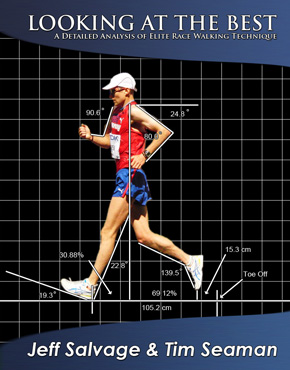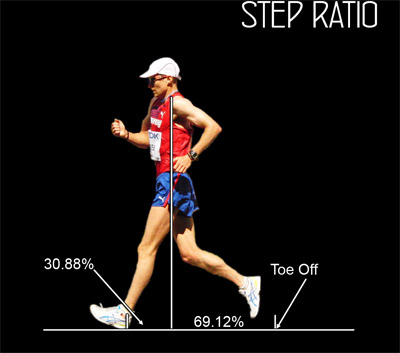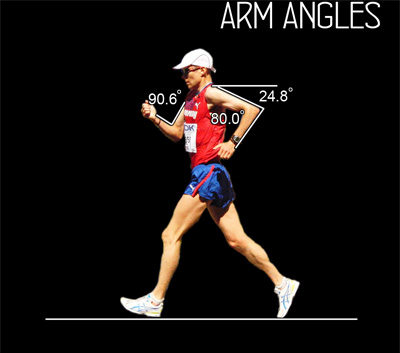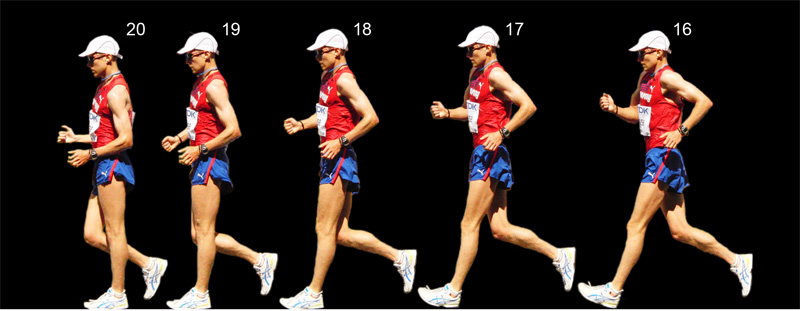RaceWalk.com Shop - Looking at the Best

Looking at the Best, A detailed analysis of elite race walking technique takes the discussion of race walking locomotion further than ever before. By combining high resolution - high speed photography with computer software and detailed measurements, we paint an image of exactly how the best race walkers in the world stride forward at speeds approaching 10 mph (16 kph). Instead of theorizing the body motions comprising ideal race walking technique, we analyze the race walkers from elite race walk competitions featuring the very best race walkers in the world.
Under race conditions (primarily at the 12th World Championships in Berlin), we see the good, bad and ugly with regard to technique. By using real race photographs we take the discussion out of the proverbial laboratory and examine how race walkers do what we want to do, race fast.
The definition of race walking requires that race walkers show no “visible to the human eye” loss of contact with the ground. After reviewing over 100,000 photos of elite race walkers, no walkers at top speed maintain contact. One controversy that is sure to develop as a result of our analysis is the obvious flight phase shown when high speed photography is utilized. Pushing themselves to world class speed requires that there is a “visible to the camera eye” flight phase. How long should this be is subjective, but by comparing sequences of photographs to judge’s tally sheets we begin to get a picture of what “visible to the human eye” really means.
Our discussion of technique goes much further than mere legality. We look at what is the ideal:
- duration of the flight phase as well as the distance travelled during loss of contact
- step length
- step length’s ratio related to height
- the front vs. back distribution of the step
- angles between the feet and the ground at various points of the stride
- angles of the arms with relation to the body
- maximum height of the knee or foot during the stride
- pelvic and torso displacement
- points in the stride where various actions take place, such as the foot becoming parallel with the ground or the support leg flexing
- body lean
Our analysis includes 13 elite race walkers showing every phase of a walkers stride. As stride duration changes from walker to walker, the number of images varies for each athlete averaging over 22. Each individual is then analyzed for 26 measurements and more detailed images of the stride are shown through 16 illustrations demonstrating our measurements. This reveals the variation in style between athletes. It is important to note that there is not one style that is absolutely perfect for everyone. Variations in body structure, strength, and flexibility dictate that deviations occur. Unfortunately, due to technical difficulties and massive interference with the camera car, we do not have enough footage of the women to include a statistically relevant number of photographs to include in this text. We hope to follow this text with a 2nd edition that contains photographs from the next World Cup and includes women.
In addition to the individual walkers’ images we also include a summary illustrating the race walker with the smallest and largest value for each measurement. When showing both walkers side by side it helps you visualize the difference of each measurement. All of the measurements for all of the walkers are then correlated to each other so that we may see what patterns exist in the data gathered. Some found were ones that we expected, others were not.
What can you do with all of this information? As they say, imitation is the greatest form of flattery, so let’s use imitation to perfect your race walking technique. By imitating the average elite walker and then photographing yourself, those who are tech savvy enough to load your images on a computer can perform a comparison just as we did. How well did you do? You won’t match our average walker perfectly, but if you aim to come close, you are sure to improve your race walking technique.
Table of Contents
DEDICATION ....................................................................2 ACKNOWLEDGEMENTS ..............................................................2
TABLE OF CONTENTS ..............................................................3
CHAPTER ONE - INTRODUCTION .....................................................5
CHAPTER TWO - METHODOLOGY ......................................................7
GLossary of Terms Used ...................................................7
List of Measurements .....................................................8
CHAPTER THREE - ANALYSIS ......................................................19
CHAPTER FOUR - COMPARISIONS ...................................................99
CHAPTER FIVE - CORRELATIONS ..................................................107
Derived Values .........................................................115
CHAPTER SIX - EPILOGUE .......................................................118
Who Should We Mimic? ...................................................118
Non-Correlations .......................................................118
Acceptable Loss of Contact? ............................................118
Accuracy of Judges Calls ...............................................119
Questions or Answers? ..................................................119 APPENDIX A - RAW DATA ........................................................120
Sample Images from the Text
Observe a few of the many photographis in Looking at the Best that demonstrate some of the many images within the text itself.

Sample image showing a walker's step ratio

Sample image showing a walker's arm angles

A portion of a sample image showing a walker's complete stride
Looking at the Best - US Orders ($27.95 + $4 S&H)
SPECIAL PRICE - Get all four Salvage and Seaman Books- US Orders ($77.85 + $4 S&H)
Race Race Walk Clinic in a BookLooking at the Best
Excellence in Training
Race Walk Faster by Training Smarter
A savings of $32.95(including S&H) if purchased individually.
SPECIAL PRICE - Get all four Salvage and Seaman Books- International Orders ($77.85 + $25 S&H)
Race Walk Clinic in a Book
Looking at the Best
Excellence in Training
Race Walk Faster by Training Smarter
A savings of $43.95(including S&H) if purchased individually.